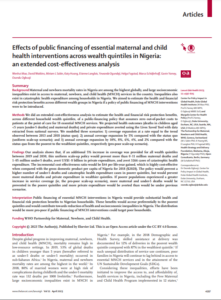
Background: Maternal and newborn mortality rates in Nigeria are among the highest globally, and large socioeconomic inequalities exist in access to maternal, newborn, and child health (MNCH) services in the country. Inequalities also exist in catastrophic health expenditure among households in Nigeria. We aimed to estimate the health and financial risk protection benefits across different wealth groups in Nigeria if a policy of public financing of MNCH interventions were to be introduced.
Methods: We did an extended cost-effectiveness analysis to estimate the health and financial risk protection benefits, across different household wealth quintiles, of a public-financing policy that assumes zero out-of-pocket costs to patients at the point of care for 18 essential MNCH services. We projected health outcomes (deaths in children aged <5 years [under-5 deaths] and maternal deaths) and private expenditure averted using the Lives Saved Tool with data extracted from national surveys. We modelled three scenarios: 1) coverage expansion at a rate equal to the trend observed between 2013 and 2018 (status quo); 2) annual coverage expansion by 5% compared with the status quo (uniform scale-up scenario); and 3) annual coverage expansion by 10%, 8%, 6%, 4%, and 2% compared with the status quo from the poorest to the wealthiest quintiles, respectively (pro-poor scale-up scenario).
Findings: Our analysis shows that, if an additional 5% increase in coverage was provided for all wealth quintiles between 2019 and 2030, this uniform scale-up policy would prevent more than 0·11 million maternal deaths and 1·05 million under-5 deaths, avert US$1·8 billion in private expenditure, and avert 3266 cases of catastrophic health expenditure. The incremental cost effectiveness ratio would be $44 per life-year gained, which is highly cost-effective when compared with the gross domestic product per capita of Nigeria for 2018 ($2028). The policy would prevent a higher number of under-5 deaths and catastrophic health expenditure cases in poorer quintiles, but would prevent more maternal deaths and private expenditure in wealthier quintiles. If poorer populations experienced a greater increase in service coverage (ie, the pro-poor scale-up scenario), more maternal and under-5 deaths would be prevented in the poorer quintiles and more private expenditure would be averted than would be under previous scenarios.
Interpretation: Public financing of essential MNCH interventions in Nigeria would provide substantial health and financial risk protection benefits to Nigerian households. These benefits would accrue preferentially to the poorest quintiles and would contribute towards reduction of health and socioeconomic inequalities in Nigeria. The distribution would be more pro-poor if public financing of MNCH interventions could target poor households.